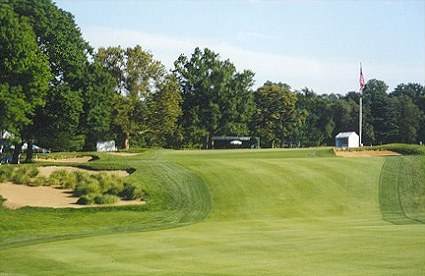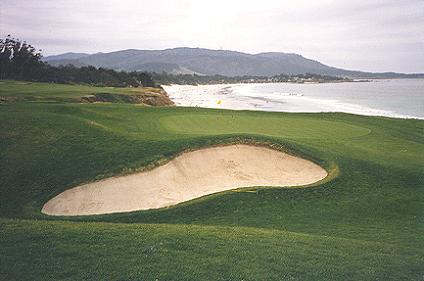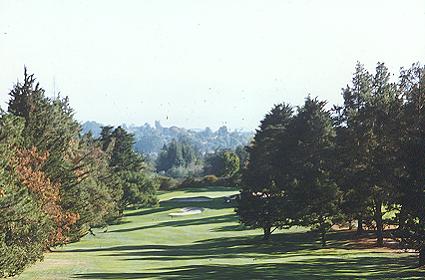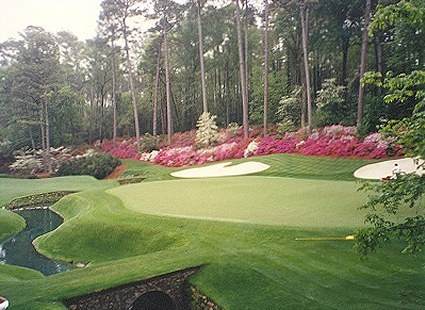Feature Interview with Geoff Shackelford Pt. I
September 1999
Geoff Shackelford is the author of five golf books, not the least of which is the Definitive History of Riviera, which must rival Chicago GC’s as the finest club history book. He has long held an appreciation for the innovative style employed by the old master architects like George Thomas. Geoff’s new book entitled The Golden Age of Golf Design was released this month and is the most revealing golf book published in recent memory. Geoff lives in Santa Monica, California and longs for the day when the 8th hole at Riviera is restored.
1. If a low-handicap friend from Great Britain were to come visit the U.S. for the first and only time, which twelve courses would you take him to see to show the best aspects of American architecture?
I’d like to try and mix it up in terms of styles and properties worth seeing even though it’s a one-time trip. There are the obvious standouts which everyone should get to see somehow, but there is one must see – not necessarily for completely positive reasons.
- Pine Valley – It’s still great, even if it’s totally overgrown today and not quite the atmosphere Mr. Crump seemed to have envisioned for his golf club (can you imagine what Mr. Crump, who intended that it NOT be a place for ‘social fetes or luxurious entertainment,’ would think of the corporate ‘chalets’ they’ve built? Or the whole member and three guest thing? I was there two years ago and it was like being at Riviera or Oakland Hills!).
- Merion – Another wonderful set of subtle but memorable greens, like Riviera, that are unforgettable as you stand on the tee or fairway and try to make decisions as to how to attack the hole. Thomas was probably most influenced by Merion, and it’s too bad more architects haven’t been.

Merion's famed last hole.
- Somerset Hills – Quirkiness at it’s finest. The most underrated course in the world, probably because it’s just a little too offbeat for most Americans who are used to pretty landscape architecture-masquerading-as-golf course design. Then again, some people who struggle to enjoy short, non-traditional courses, even find Somerset Hills to be special. So maybe there is hope.
- Crystal Downs – Typical MacKenzie course in that the routing and style of it just gives you the feeling you are somewhere special. All of his courses do that. You just know you are somewhere different and unique, and I think that’s a product of his routing and construction style.
- Shinnecock Hills – our best mixing of links style golf with classic American architecture principles.

The hard to find tenth green at Shinnecock.
- Sand Hills – our best combination of links style golf and modern American architecture.
- Riviera – To observe great strategy, to see a solid routing on an oddly shaped property, to see the standout short holes (4, 6, 10, 16) and to find out why you want to keep kikuyu grass off a property.
- Inverness – A fine example of about fourteen holes of simple, old, charming Ross architecture that is enjoyable for all. Four holes of embarrassingly bad modern redesign carried out in the name of protecting member’s egos during a major, at the expense of the design. Eighteen holes of ridiculous tree maintenance. And the first and tenth hole setting, which is arguably is the best in all of golf besides the Old Course. You get a little of everything at Inverness. Despite what the Fazio’s did, I just loved it, and there is a lot to learn here (good and bad).
- Garden City Golf Club – for it’s unique setting and old style feel.
- Cypress Point – but I will make sure to bring along the old photos in MacKenzie’s defense. Though most people don’t notice or care about the changes because it’s so beautiful.
- Pebble Beach – wonderful strategy, just a bit too cleaned up in places for me. Once again, the old photos are coming along with us to show off what Chandler Egan did in 1928 with his ‘imitation sand dunes.’
- The National Golf Links – where it all started in America.

The National - where it all started in America
2. Golf architecture has always attracted strong willed men and yet in The Golden Age of Golf Design, you note, ‘ It’s hard to imagine the at Pine Valley would be the course it is today had Crump not consulted so many brilliant minds.’ Collaboration between leading architects on the same project today no longer seems possible. What do you see as the direct consequences?
It’s strictly business, which I understand. I highly doubt MacKenzie visited many Ross courses under construction, and I’m sure Ross was not willing to spend much time helping his rivals either. The real collaborative, information sharing projects involved the amateur golfers like, Crump, Wilson, Thomas, Macdonald, Egan, etc?In terms of consequences today, I think the ‘products’ that have been created sum it all up. How many great courses have been built in the last forty years? I mean really great – timeless, unique, solid from beginning to end? Not too many. Sure the sites are not as good and the environmental restrictions are crippling, but there is a lack of ‘in-the-field’ routing work undertaken, and once things get going construction wise, even less in-the-field tinkering or imagination. I would love to get someone who understands strategy teamed up with Mike Strantz, because what he’s doing now it so interesting visually, but his greens are some of the stupidest things ever conceived. They just ruin the courses because they don’t make any sense from a strategy point of view.
I think Crenshaw and Coore are doing great work partially because they have a talented crew who know that during construction, if they see an opportunity being missed in the design, that they can try to add a touch here or there and that Ben and Bill will be open to it. Ben and Bill encourage their crew’s input, and that is why their courses are in a class above most others today. If you ask them about many of their holes, they will invariably mention how a certain feature was Dave’s idea, or Jeff’s idea, or Dan’s or Tom’s. And they aren’t just saying it to sound good, they are just saying it because it is how things work with them and they are proud to have gotten input from the crew. Most modern architects could never do such a thing. They are paranoid, and rightfully so, since most of them have no concept what the great architects did to be considered great.
3. In your new book, you credit Harry Colt with the placement of the 5th green at Pine Valley. Where was Crump tentatively going to place the green and where do you think the present version ranks among the great long one-shotters in the game?
My understanding from the research I did at the club and in reading the two Pine Valley books was that Crump wanted to put the green just barely on the other side of the lake and to have a dramatic drop shot par-3. However, this created problems for number six, in that there would have been a very long walk to get to the proposed sixth tee, and it would have been an awkward break in the flow of the course. During his one-week visit, it is well documented that Colt suggested making number five a long one-shotter up the hill so that the sixth tee could be a fairly short walking distance away. In the end, it all worked out because when Crump rerouted 13, 14, and 15, fourteen went from being a short par-4 to the downhill par-3 over water that Crump wanted to make each of his par-3’s so distinct. It certainly is a tough hole and pretty, but the best thing it does is lend excellent variety to the overall design of the course, so in that sense it is a great par-3 in my book.
There is a strange unknown story about what went on at Pine Valley in those early days with regard to design credit. Because all of the evidence points to it being largely Crump’s vision, design, etc?Yet, there is an extensive article from 1914-15 that appeared in Golf Illustrated. It is written by Reverend Simon Carr, Crump’s close friend, and in it he refers to the course as Colt’s design all the way, with Crump merely being on the green committee. I find it very strange, and the only thing I can surmise is that perhaps many of the founding members or prospective members were concerned about Crump’s ability to give them a good course, and so it was agreed upon that Colt (the big name) would get the credit to appease those who wanted a Colt ‘signature’ design. I mention it only because if this is how it played out, it shows how little times have changed.
4. Based on the photograph of Ross’s bunkering on page 154 in The Golden Age of Golf Design, what if any credit does Dick Wilson deserve for the bunkering at Seminole?
That picture is very old, pre-Dick Wilson, and speaks for itself I think. The bunkering is very distinctive, identical to what Wilson is credited with years later, but which he apparently did not do. And looking at the variety of bunkering Ross did over the years, I’d say it was his firm’s chosen bunkering style at Seminole. I really don’t know what Wilson did to the course in the thirties. Hopefully it was before he really went on a rampage ruining classics.
5. Since Egan’s 1928 redesign of Pebble Beach, which course has seen a greater change in its bunkering – Pebble or Cypress Point?
Cypress Point. Thirty-two bunkers have disappeared, many of which were very important strategically or aesthetically. The remaining bunkering at Cypress has all deteriorated compared to what was built. We still don’t have a view from the tee on 12 at Cypress, but there used to be a great little aiming bunker on the left middle of the fairway about 275 yards out, and at least two bunkers down the right at about 230 yards. They are all visible in aerials, which should be enough to get them restored someday, which the club is working towards doing over the next few years. Pebble Beach’s ‘bunkering’ is a different situation. Those ‘imitation sand dunes’ probably just evolved into bunkers or were made bunkers by the various superintendents. Though they aren’t nearly as spectacular today as what Egan had, the bunkering at Pebble Beach is positioned basically as Egan intended. So strategically it is still very good, and for the amount of play they get, the imitation dunes would make it an eight hour round anyway.

One of Pebble's deepest bunkers, this one in front of the ninth green.
6. The early photos of Pasatiempo show a virtually treeless interior. Did MacKenzie plant any of the trees that exist today? If not, would he argue that Pasatiempo should be returned to that original treeless state?
From the photos I’ve seen, he planted very few trees. Particular in the first hole/ninth hole area. I think he would want the course to be mostly treeless. It’s a matter of liability now in some cases that they just have to have trees, and even the Good Doctor might have to concede some of the trees are needed to keep the Santa Cruz personal injury attorneys from putting the club out of business. But I think the driving range and the many lost bunkers, lost pin locations and the added ‘false front’ on 16 (that is not MacKenzie’s evidently), would probably irk him just as much.

Is this a forest or a golf course?
7. What three architects’ (past or present) body of work do you admire the most and why?
A.W. Tillinghast for his variety of styles. To think he built San Francisco and Somerset Hills within two years of each other is just amazing. But he created so many courses that are lost or that have deteriorated, that it is hard for anyone to get past the usual examples when talking about him. The Baltusrols and Winged Foots are great and all and I’m tired of them getting a bad rap from people like Nicklaus who say they were only great when the trees grew up. But when you start realizing what else Tillinghast left behind, and that most of it is gone, it’s so sad. In its day, Philadelphia Cricket was very special and had some wild bunkering schemes. But it’s basically all gone. Golf Journal recently cited it as untouched, which is like saying Augusta is untouched. If the original Tillinghast design of Philadelphia Cricket were around today, it’d be ranked in all the various lists and cited as almost comparable to his best work in terms of unique architecture.
George Thomas for his overall style. I still discover things at Riviera that he and Bell created which architects today could learn from, particularly with how they incorporated drainage swales naturally and strategically. His greens were not as large or bold contour-wise as MacKenzie’s or Tillinghast’s or Ross’, but he usually created one or two key features within each green complex. Those features stick in your mind as a player when you are trying to figure out how to attack the hole – a style I love and the reason most people love his work: it’s so memorable. From a strategy standpoint, I think his simplicity in green design was a good way to design holes. I don’t care for huge, rolly-poley greens which are difficult to remember when you stand in the fairway or on the tee because the strategy is pointless if certain features don’t stick in your mind as you plan your attack. Of course, I am biased because I grew up playing Thomas’s courses, but the more I see, the more I realize he was a genius.
Alister MacKenzie for genuinely preaching and carrying out the ‘playable for all, yet challenging for good player’ mantra (that is abused daily by contemporary architects). The moderns all claim they do the same style as MacKenzie, yet few understand strategy and subtlety well enough to actually pull it off, but MacKenzie did. I’ve been very lucky to see many old photos of much of MacKenzie’s California work, and it is depressing how little is left. Maybe 5-10% of his original hole designs remain as he envisioned them. Lesser known courses where he did some remarkable work – Lake Merced, Sharp Park, Meadow Club – are just completely gone. His bunkering and ability to blend everything so deftly was incredible. Even his not-so-subtle mounding around greens, which seemed to be a trend late in life, was wonderfully carried out. Like the eighth green at Augusta or fourteenth at Pasatiempo. I can’t think of many architects who have pulled off that kind of mounding around greens like MacKenzie and his team did.
8. In your book The Good Doctor Returns, MacKenzie is based at The Valley Club of Montecito. We have only seen parts of the course from the road – just how neat a course/place is it? Did you toy with having MacKenzie based at Pasatiempo or Cypress Point?
I based the Good Doctor out of The Valley Club for several reasons. One, it’s one of his best designs in terms of being a pure joy to play. Two, there are those two little cottages at Valley Club overlooking the ocean and practice range, and who wouldn’t want to hang out there? Three, I didn’t really want to address the modern day Pasatiempo or Cypress Point designs. I enjoy the people at both places and didn’t want to have MacKenzie discuss either in depth, because he would not be pleased with what is left of his work at either one. His heart wouldn’t be able to take it. Thankfully, both Pasatiempo and Cypress Point are in the process of restoring his designs, albeit slowly. Pasatiempo has Renaissance Golf Design doing some great work, I only wish they’d just let them do it all at once and return it to it’s original splendor. Cypress Point, which has lost thirty-two bunkers by my most recent count, is just not the course MacKenzie left us. Number one and eight greens are not his. Number seven has lost the whole front half along with two bunkers. And the native grasses and ice plant are out of control. Number nine at Cypress, which gets cited as one of the great short two shotters, is very strange these days because there is no temptation to go for the green, which is the whole essence of that hole in MacKenzie’s design. The tall grass has overtaken the dunes and made it an almost automatic double bogey if you stray even slightly. The hole has been stripped of it’s strategic charm. Number eighteen used to be a virtual island fairway surrounded by sand. Today you get on the tee and all you see are Cypress trees and have no idea where to go. But Jeff Markow the superintendent there is working with Jim Langley and the membership to put together a long-range, in-house restoration plan. He understands all of these issues and has already done a great job restoring the greenside bunkers on sixteen. I am currently compiling a book in cooperation with the club called Dr. MacKenzie’s Cypress Point. It will include historic photos of all the holes, many with MacKenzie and Hunter playing the course. I also have an article by MacKenzie about the course that no one I know has seen. Although it raises more questions than it answers. It was published well after the course had opened, and it lists the sixteenth at 350 yards… I also have extensive quotes from Hunter published around the same time. Same problem. He lists sixteen at 350 yards…

The Valley Club exudes charm.
But back to The Valley Club. It’s not MacKenzie’s and Robert Hunter’s trickiest or most strategically profound design, nor was it meant to be. It is just the most pleasurable design and beautiful setting I know of in all of golf. I have played it about forty times, thanks mostly to my two years at UC Santa Barbara before I transferred to Pepperdine. I shot as low as the high sixties and as high as the high eighties out there, and all sorts of stuff in between. It is the perfect example to emulate for a country club course, that is, if you are looking for something that is great fun for the older members and which will still give the average and good players an interesting test (there is that overused cliché! But it’s so true at Valley Club). Tom Doak’s bunker restoration is really bringing it back to a different level, and they have a great superintendent in Sean McCormick who just did a bunker on eleven. And Sean is taking great care of the place and getting the greens back to being as firm and fast as they were when I played it every Monday for two years! Those were the days! I never missed a Monday at the Valley Club.

The difficult third at the Valley Club
9. What are your five favorite books on golf architecture?
- The Links, Robert Hunter
- The Spirit of St. Andrews, Alister MacKenzie
- Golf Architecture in America, George Thomas
- The Architectural Side of Golf, H.N. Wethered and Tom Simpson
- The Anatomy of a Golf Course, Tom Doak
10. What are your favorite short par 3 (under 140 yards), short par 4 (under 340 yards) and short par 5 (under 500 yards)?
Short par 3 – Seventeenth at Sand Hills
Short par 4 – Tenth at Riviera
Short par 5 – Thirteenth at Augusta

I am just amazed how rarely modern architects try to build take-off’s or even near replicas of the tenth at Riviera. Nicklaus claims the first hole at Sherwood is very similar to ten at Riviera in playing style, which is a complete joke. One very prominent design firm called me asking for Thomas’ ‘as builts’ of the tenth and I explained we really didn’t have that kind of thing just lying around, nor did Thomas do such plans back in the twenties. The architect in question was surprised, and mumbled something as if all old architects were unprofessional hacks because they didn’t sit in an office and churn out pretty blueprints! But I then explained that it was nice to hear someone was trying to mimic the playing qualities of the tenth. However, the design associate in question said they likely would not build a replica because their short hole was meant for a public course and the well-bunkered Thomas green would be too tough for such a thing. And best of all, he said, they weren’t ‘about copying old holes’ anyway. So I suggested doing a version of the hole as Thomas had it in 1927 (prior to the 1929 addition of greenside bunkers). The green was slightly crowned and still called for an approach from the left side for the best angle. But the architect never understood how the bunkerless, crowned green would work for his public course in keeping play reasonably fast and not beating people up too much. Thankfully, Coore and Crenshaw have built such a green, with a much more severe ‘crown’ than ten at Riviera had prior to the bunkering. Their version is the fifth at Cuscowilla in Georgia, which is another great short par-4.

The game's finest short two shotter? The tenth at Riviera.
11. If time and expense were not issues, which five courses in the world would you most like to play for the first time?
- Cape Breton Highlands, Canada (Thompson)
- All of the Russell/MacKenzie courses in Australia (I know, cheating)
- Morfontaine, France (Tom Simpson)
- Prairie Dunes, Kansas (Maxwells)
- Chicago Golf Club, Illinois (Raynor)

The tricky pitch to the fourth at Cape Breton Highlands.
12. Is there a feature from the Golden Age of golf architecture that you think is missing from course design today?
G.S.: No one feature. Just basically all of the key features from the Golden Age. Subtlety, mystery, natural looking beauty created by man, variety, irregularity, forced carries, decision-making, encouraging recovery play, skillful incorporation of drainage, intelligently-contoured greens, plenty of short holes, prudent routings, etc… There are only a few people today doing anything close to what was done in the twenties, and in time hopefully they will not be restricted by clients or land or wetlands or overly-strict liability concerns, and will be able to match or top the Golden Age work, but it will take a more accepting golfing public. I just don’t see the kind of openness out there right now for some of the more interesting styles of architecture, like boomerang greens, quirky contours or semi-blind approaches for miss-placed tee shots. As you will see in ‘The Golden Age of Golf Design,’ the great old architects were bold, sometimes downright wild in their designs, and constructed their courses so artistically. They also were great communicators – just look how they wrote and the kind of things they managed to accomplish when the ‘clients’ were just as uninformed as they are today. Their bunkering looked unique and consistently served a strategic purpose. Bunkering wasn’t merely to ‘frame’ holes or placed to penalize wayward shots. They put thought into all of their hazards and all of their mounds and most of all, into their routings. Today, few architects devote time to any of those elements. Yes, it’s a brutally difficult business and there are tons of agencies to deal with and a fair share of neurotic developers who get in the way. But that just is no excuse for some of the stuff that is getting built and the cost it’s being built at. Placing bunkers and envisioning various strategic possibilities just isn’t that hard, I’m sorry. But what’s most amazing is that MacKenzie and Thomas both predicted that their generation was merely laying the groundwork for future generations to do more amazing design work. The next generation was expected to come along and build all sorts of imaginative courses with multiple avenues of play, multiple tees and wild pin placement options that would create the ultimate in variety. Instead, we’ve gone backward and I think most of us would just be thrilled to see courses built as well as the Golden Age designs again. Taking it to another level will most likely be for another generation. How can the majority of modern architects improve on the Golden Age work if they don’t even know or understand what went on before them? Or care?
The End








